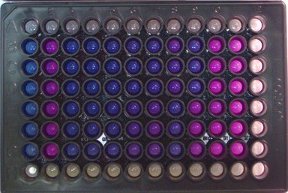
|
|
|
There are about 30 human proteins susceptible of misfolding and deposition as amyloid fibrils and amorphous aggregates impairing normal tissue function. While for years it was thought that tissue dysfunction was a consequence of mechanical compression and displacement by the depositing proteins, recent evidence suggests that small oligomers, either precursors of these amyloid structures or generated through alternative aggregation pathways, play a role in the pathogenesis of these diseases.
Our research is focused on the understanding of the cellular aspects of cell damage in the transthyretin amyloidoses.
The protein transthyretin (TTR) is a homotetramer of about 54 KDa synthesized predominantly in the liver and in choroid plexus (brain). TTR circulates in plasma where it transports retinol through association with retinol binding protein, and thyroxine. In the cerebrospinal fluid TTR is the main transporter of thyroxine. More recent experimental evidence suggests that TTR might also be involved in binding and detoxification of unwanted metabolites including misfolded proteins.
TTR itself can misfold and aggregate. The clinical syndromes associated with TTR deposition are Senile Systemic Amyloidosis (SSA) in which wild type protein deposits are found predominantly in hearts of affected individuals. Autopsy derived data indicates that about 25% of individuals 80 years or older have wild-type TTR deposits. Familial amyloid cardiomyopathy (FAC) and Familial Amyloidotic Polyneuropathy (FAP) are autosomal dominant diseases resulting from the deposition in heart or peripheral nerve, respectively of one of the more than 100 TTR mutants discovered so far. The familial forms of TTR amyloidoses are usually of earlier onset than the senile form due to lower kinetic and thermodynamic stabilities of the mutant TTR respect to the wild type form.
Our studies are directed at understanding the molecular mechanisms of pathogenesis in TTR misfolding diseases using tissue culture systems that resemble the targets of TTR deposition. We analyze the effects of wild type and TTR variants on cell death and survival and its mechanisms of action using biochemical, biophysical, genomic, proteomic and molecular biology tools. The ultimate goal is to find markers indicative of the onset of these diseases and to use them to develop novel treatment approaches.
We use the tissue culture models to screen small molecules that will prevent TTR-induced cell damage thus, they may became drugs to treat and to prevent TTR deposition. For that we collaborate with the laboratories of Prof Jeff Kelly at Scripps and Prof Isabella Graef at Stanford.
In collaboration with Prof Joel Buxbaum we have established that murine TTR is kinetically more stable than human TTR, although the crystal structures are practically identical. In vivo, transgenic mice having low copy number of human TTR and the endogenous murine TTR did not develop amyloid deposits. When the same transgenics where breeded in the TTR knockout background, TTR deposits were readily found. Using biochemical and biophysical tools we have established that mouse and human TTR form mixed tetramers. The resulting TTR molecules have different stability than pure human or pure murine TTR, explaining the lack of phenotype of the transgenic animals.

Also in collaboration with the Buxbaum laboratory we are using biochemical and biophysical techniques to understand the interaction between TTR and amyloid beta peptide found deposited in brains of Alzheimer's Disease (AD) patients. We have recently shown that TTR ameliorates the phenotype in AD transgenic mice, while the lack of endogenous TTR increases the AD pathology. We are now studying more in detail the interaction between amyloid beta and TTR.



